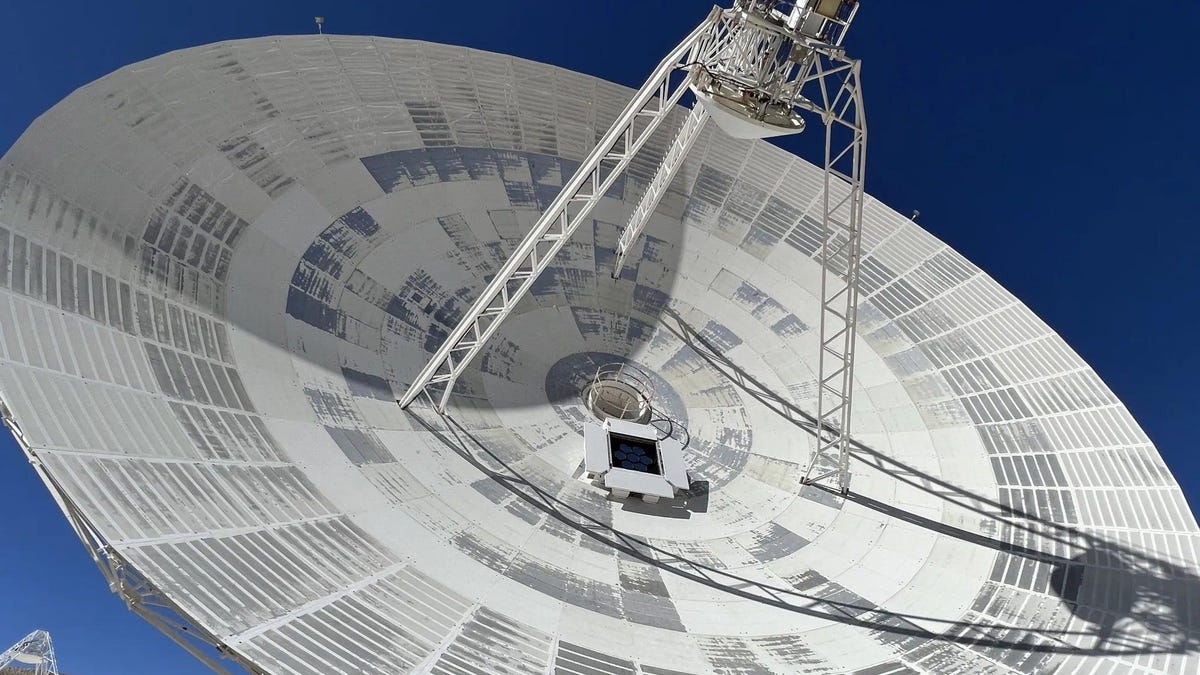
NASA equipped its legacy communications network with a hybrid antenna that allowed it to receive radio frequency and laser signals for the first time, helping the space agency keep up with the growing number of missions traveling through deep space.
Deep Space Station 13, a 112-foot (34 m) experimental hybrid radio-optical antenna, tracked and decoded a signal from a gold-covered laser transceiver attached to NASA's Psyche asteroid probe, the space agency recently Announce. The Deep Space Optical Communications (DSOC) experiment was launched aboard the spacecraft The Psyche spacecraft on October 13, 2023 As the first demonstration of laser or optical communications from places as far away as Mars.
On January 1, 2024, the hybrid antenna delivered the team's uploaded image to DSOC prior to Psyche's launch. “Our hybrid antenna was able to successfully and reliably lock and track the DSOC downlink shortly after the technology demonstration was launched,” Amy Smith, deputy director of DSN at JPL, said in a statement. “It also received a radio frequency signal from Psyche, so we demonstrated simultaneous radio and optical communications in deep space for the first time.”
The antenna is part of NASA's Deep Space Network (DSN), a collection of giant radio antennas spread across different parts of the world that the space agency has relied on to transmit communications through its deep space missions over the past 60 years. The network consists of 14 dishes distributed among three deep space communications facilities at Goldstone in the Mojave Desert in California, another near Madrid, Spain, and a third near Canberra, Australia. The latest trial took place at a California facility.
A reliable communications network is struggling to keep up with demand as NASA launches more missions into deep space. A recent report issued by NASA's Office of Inspector General revealed this Demand for DSN exceeds supply by up to 40% sometimes. By retrofitting the radio antennas with experimental hybrid capability, NASA hopes to transmit more data at a faster rate, as well as help the DSN keep up with high demand.
In late 2023, the hybrid antenna transmitted data from a distance of 20 million miles (32 million kilometers) at a rate of 15.63 megabits per second. That's about 40 times faster than radio frequency communications at that distance, according to NASA.
This dramatic increase in data transfer speed allows more detailed information to be transmitted from deep space missions, enhancing our understanding of the solar system. It also paves the way for more efficient communication with future space exploration, which could revolutionize how we explore and study our universe. Furthermore, laser communications can transfer data at a much higher rate, enabling rapid transmission of high-resolution images and comprehensive scientific data from distant space missions.
Deep Space Station 13 has seven ultra-resolution segmented mirrors (similar to the hexagonal mirrors of the Webb telescope) attached to the inside of its curved surface. Each mirror reflects the laser photons and redirects them to a high-exposure camera attached to the antenna subreflector, which is located above the center of the giant DSN dish. The laser signal collected by the camera is then transmitted through an optical fiber that feeds a cryogenically cooled semiconductor nanowire single-photon detector, which acts as a downlink ground station.
“We use a system of mirrors, tiny sensors and cameras to effectively align and direct the laser from deep space to the fibers reaching the detector,” Barzia Tehrani, deputy director for ground communications systems and delivery manager for the hybrid antenna at JPL, said in a statement.
The team wants to test the hybrid antenna at a distance equivalent to the distance between Earth and Mars at its farthest point (or two and a half times the distance between the Sun and Earth). In June, the Psyche spacecraft will reach this distance, and its onboard laser transceiver will be ready to send a signal to the antenna.
In December 2023, DSOC broadcast a 15-second video Shot of an orange cat named Taters chasing a laser pointer up and down a sofa 19 million miles from Earth. It's hard to beat that, but we'll see what the laser transceiver has in store for us next.
For more space travel in your life, follow us X (formerly Twitter) and custom bookmark Gizmodo Spaceflight page.

“Web maven. Infuriatingly humble beer geek. Bacon fanatic. Typical creator. Music expert.”





More Stories
Scientists confirm that monkeys do not have time to write Shakespeare: ScienceAlert
SpaceX launches 23 Starlink satellites from Florida (video and photos)
A new 3D map reveals strange, glowing filaments surrounding the supernova